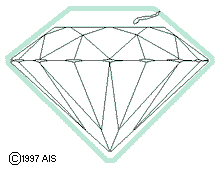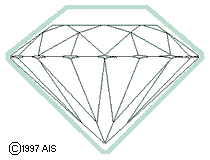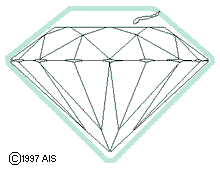
 AISociety ™ Appraisers International Society ™ AIS - Personal Property Appraisal's Global Valuation Standard ™ GVS
―――――――――――――――――――――――――――――――
Since 1982, AIStandards™ & AiCertification™ developer Elly Rosen has been the primary developer & instructor
of professional principles, applied ethics, procedures, methodology and reporting for multi-specialty, attached
and movable Personal Property Appraisal & Valuation. Leader of the very first education, testing, certification
and referral programs, now Elly and the Global AiCertification Team are in the 5th-Decade Global AIStandard
AISociety ™ Appraisers International Society ™ AIS - Personal Property Appraisal's Global Valuation Standard ™ GVS
―――――――――――――――――――――――――――――――
Since 1982, AIStandards™ & AiCertification™ developer Elly Rosen has been the primary developer & instructor
of professional principles, applied ethics, procedures, methodology and reporting for multi-specialty, attached
and movable Personal Property Appraisal & Valuation. Leader of the very first education, testing, certification
and referral programs, now Elly and the Global AiCertification Team are in the 5th-Decade Global AIStandard
Current AIStandard's 5th-Decade Deep-Discount Introductory Rates
are at Go5th-Decade.AISociety.com
Professional Valuation Appraisers - CHECK THIS OUT:
Elly Rosen's 34th-Anniversary Year Offering of His
Live, Online 55-Classroom Hour Course:
"AiS-GJ ™ Appraising Gems & Jewels"
on G&J Valuation & Appraisements for Professional Practitioner
IS NOW IN "Open Enrollment" For ALL Regardless of Membership!
for enrollment opportunities in his live classes or through self-paced study
Register AiCertifications Live or Self-Study G&J Triple-Crown Program
| | |
Appraiser Certification |
|
Jump To: AiCertify Home | AiS-ToS | Register/Pay | AiCore | AiSCV-AVS | AiSCV-GJV | AiSCV-EHV | AiSCV-FAV |
Appraising 'Old-Cut' Gemstones
Old cuts are often valued on a modern scale
rather than within their own market,
which may not properly serve
clients and their third parties
by Elly Rosen, AiSCV AVS-GJV, AiV, FGA, GG
©1983, 1997, 2002, 2014 with all Rights Reserved
Based on Elly Rosen's teachings on this subject starting in 1983, this article furthering the subject appeared in the October 1997 issue of Jewelers' Circular Keystone Magazine (JCK), pp 160, 166, as part of the author's JCK Appraisal Q&A series, and as part of the Rosen On Appraising series which ran on the JCK Web site from August 1997 through June 1998.
Related principles and applied procedures have been further advanced during the 2011-14 AiSCV-GJV diploma program's AiS-GJ Gems & Jewelry/Jewellery Valuation & Appraisement course offerings. AiS-GJ alumni and enrolled candidates can use the AiCloud link at the bottom of this page to access Elly Rosen's 2013 2-hr AiRecording on this subject which opened AiS-GJ™2013 with the program's first session on Corrective Gemology for Valuation.
- Q&A Intro - Recutting formulae just don't work (with graphic illustration)
- Misguided tradition
- Insurance appraisals
- Other problems with "recut" formulae (with graphic illustration)
Does a 'Modern Cut' live inside an 'Old Cut'?
Maybe, but it isn't there now!
[Author’s note: The accompanying illustration is for an imaginary modern cut inside of an old-European or transition cut. All of the considerations of this Q&A become even more extreme if the existing stone is the more classically cushion-shaped “old-mine” cut.]
More and more gemological appraisers are beginning to realize this misguided notion of appraising an old cut as though it were already recut to modern proportions simply does not work. It’s fine as a teaching tool, but not useful for real-world valuation.
We will touch on some of the many things wrong with this “traditional” practice. The most fundamental problem: it’s rare that a given old cut will sell for the same amount as its “modern recut equivalent.” They sometimes sell for less and sometimes for more, depending on quality, setting and various elements affecting buyers and sellers at auction or other markets.
When I took my diamond grading class with the Gemological Institute of America in the late-1970s, we were taught a diamond, even a modern cut, is to be valued by deducting percentage points for whatever elements of cut cause it to deviate from Tolkowski’s Ideal Cut proportions. Again, this was fine as a tool for teaching relative value of cut parameters, but it rarely results in accurate real-world selling prices for the existing stone.
If this procedure doesn’t work, why do so many do it? When I was using this approach in the late 1970s – before professional appraisal education – I did it because I didn’t know of any other way. It seemed convenient and logical to hypothetically turn the diamond into a modern cut, something I could value. It’s a fair assumption this is why people use this method. It serves as a substitute for actual knowledge of the market for old goods, but maybe it’s time we consider it a poor substitute. If it’s the only alternative, then perhaps we would be better off accepting what we don’t know and leaving it to those who do.
Formulas and price guides do have a limited place in valuation, when used properly as an adjunct to market knowledge. But when they are used as a substitute for market knowledge, they are used improperly.
Misguided Tradition
The same applies to many scenarios where the appraiser arbitrarily decides to value any gem material as though it has already been cut into something else. The worst abuse I’ve seen was with donation appraisals of the late 1970s and early 1980s. For example, a 13-lb. brown topaz crystal that cost $750 was given a fair market value of over $1 million. The basis of this “value” was that the already irradiated crystal could be turned blue by heating and then cut into any number of faceted blue topaz stones.
The crystal was valued at what those hypothetical cut stones would sell for. Four “experts” gave testimony supporting this argument. The primary foundation for the argument was that “it is tradition in the jewelry world to value gemstone materials based on their potential yield.” The court did not accept this argument and decided on a fair market value of $750. I should stress this was not an isolated incident. Once the ball gets rolling on misconceptions, they develop lives of their own.
Insurance Appraisals
It should be obvious that when the question is the fair market value of the existing item, the appraiser’s opinion must be based on what a similar item sells for. However, the replacement objective of insurance appraisals is more complex. Alternatives are available and should be discussed with the client before proceeding.
Alternate forms of the property need to be considered in insurance scenarios because insurers offer different options in their policies (or contracts):
- Full-value policies allow old or used items to be insured for replacement with a new or modern equivalent or for a check to be written for the consumer’s cost of a new item. These are also referred to as valued, replacement or agreed-value policies.
- Cash-value or non-valued policies set the company’s liability at the value of the existing item, in quality and condition at the time of loss.
Either policy type might include a clause limiting the insurer’s liability to the cost of repairing or replacing the item. Therefore, whether it’s an old couch, a refrigerator or antique or period jewelry, our client might need the replacement cost for a comparable “used” item or for a new or modern equivalent. In most states, the client can pay a few dollars more in premium and get “old” replaced with “new.”
This is the client’s decision, and he or she should be aware of the arbitrary approach of the appraiser based on a lack of familiarity with the right market. If we as appraisers are not familiar with the most relevant market for the item, we should explain that to the client, say we can do an appraisal for only one approach and indicate the report will be limited for that intended use only.
If the client is unsure what policy he or she might get and needs the numbers to help make the decision, the appraisal should be written for both scenarios, providing replacement cost for the existing item and for a hypothetical “new” one. This is where the confusion really arises. Most “gemological appraisals” would be written to replace a 1.35-ct. G VS1 old-cut diamond with, let’s say, a 1.10-ct. “equivalent” modern cut. Why? What makes that “equivalent”?
The theory is that if we replace with a modern stone, we have to imagine it as recut (by reducing the size, we would figure on a total stone value that is equivalent to the total stone value of the existing old cut). The argument behind the theory is that we can’t write the appraisal for replacement with a more costly stone. However, this appears to be a misguided imperative based on misguided motivation. It seems more logical that the “modern equivalent” of a 1.35-ct. G VS1 old cut is a 1.35-ct. G VS1 modern cut.
Does it cost more? Of course it does! That’s what the various forms of full-value policies are all about and why premiums are higher. Even when writing insurance appraisals for replacing an old cut with a modern equivalent, there appears to be no need or justification for recutting formulas.
Recutting formulas do have uses for gemologists and appraisers: if the client wants to find what the stone might recut to, evaluating options for recutting damaged stones or providing the value of loss in insured damage appraisals. (However, federal casualty loss appraisals are different.)
Other Problems With "Recut" Formulae
The previous discussion addressed the valuation problem. But it’s far from the only one that results from such arbitrary “modernization” of property based on the decision of an appraiser. We should touch on at least a few others:
- What if the client wants the “old” item replaced with a comparable piece and not our notion of “better?”
- How would this situation come out if an Art Deco piece was mounted with a pair of old-cuts or multiple stones of meaningful size. Do we write the appraisal based on modern cuts? What happens if one stone is lost?
- Suppose the diamond was a 5-ct. D flawless old-European cut and we wrote the appraisal for replacement with the modern cut “inside” the current stone. The client hits the stone, resulting in a serious gletz on the side of the table facet. Couldn’t the insurer argue the insured has had no loss because our hypothetical inner modern cut is still intact as a D flawless? Logic would say the insurer should pay just for recutting. How much of a loss will our client now incur in reality?
Some appraisers have suggested appraisals for old cuts should be written for a modern cut of the same diameter of the existing stone. They argue that if a stone was then lost, it would be easy to replace the stone in the existing ring. This doesn’t seem to make sense because we aren’t appraising the old-cut in a vacuum. If it’s an existing old style piece, we appraise the whole thing for replacement with a comparable period piece or we appraise the whole thing for replacement with a modern equivalent. We wouldn’t appraise the ring for replacement “as is” and the stone differently. Also, with this approach, the replacement would end up improperly cut with a loss of internal reflection and brilliance.
Some appraisers have complained they can’t find prices for old cuts. This usually means the appraisers have to become more familiar with the market for such items. Such stones sell regularly at auctions, for example, and there are a growing number of dealers who handle old cuts.
AiSCV-GJV Alumni & Enrolled Candidates:
Course AiRecording Update Is in the AiCloud
"Common Errors & Misconceptions in Appraising `Old-Cuts`"
is the opening topic of
the AiSCV-GJS Gems & Jewelry Graduate Title Program's 1st-session:
AiCorrective Gemology for Valuation - 1
AiSCV-GJV™ enrollees and alumni can access the full 63-minute audio-visual AiVideo of the latest updates to ths subject in the opening "AiCorrective Gemology" session of the online "AiS-GJ™ Appraising Gems & Jewels" course in the AiCloud Tab by clicking on the link below. That should open the AiRecording into the AiCloud viewer, for current AiS-GJ AiCandidates & Graduate Alumni, where it can also be downloaded:
Presentation Q&A-Discussion Update AiVideos are linked here for AiCandidates & Graduate Alumni
Comments
-
Questions & Comments are Most Welcome! Use the above link to email me at EllyRosen@AISociety.com, or post your Comment or Question here.
-
I am so glad I took the class!




